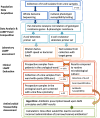Genome-based development and clinical evaluation of a customized LAMP panel to rapidly detect, quantify, and determine antibiotic sensitivity of Escherichia coli in native urine samples from urological patients
- PMID: 39775368
- PMCID: PMC11880174
- DOI: 10.1007/s10096-024-05030-3
Genome-based development and clinical evaluation of a customized LAMP panel to rapidly detect, quantify, and determine antibiotic sensitivity of Escherichia coli in native urine samples from urological patients
Abstract
Purpose: We designed and tested a point of care test panel to detect E.coli and antibiotic susceptibility in urine samples from patients at the point of care in the urological department. The aim of this approach is to facilitate choosing an appropriate antibiotic for urinary tract infections (UTI) at first presentation in the context of increasing antibiotic resistance in uropathogens worldwide.
Methods: We analyzed 162 E.coli isolates from samples from a university urological department to determine phenotypic and genotypic resistance data. With this data we created customized LAMP (loop-mediated isothermal amplification) panels for a commercial machine with which to detect and possibly quantify E.coli and six antibiotic resistance determinants. In a second step we tested these panel(s) for diagnostic accuracy on 1596 urine samples and compared with routine microbiological culture.
Results: E.coli was detected with 95.4% sensitivity and 96.1% specificity. Dynamics of the LAMP amplification could be used to gauge bacterial loads in the samples. Antibiotic sensitivity was detected with good negative (sensitive) predictive values: ampicillin 92.8%, ampicillin/sulbactam 96.4%, cefuroxime 92.8%, cefotaxime 97.8%, trimethoprim/sulfamethoxazole 96.5%, ciprofloxacin 96.8%.
Conclusion: The LAMP panel provided E.coli detection and sensitivity information within one hour and thus could principally guide initial antibiotic therapy upon patients presenting with UTI. The panel helps to select initial adequate antibiotic therapy as well as providing diagnostic stewardship. Follow up investigations will expand the test system to other uropathogens.
Keywords: Antibiotic susceptibility testing; Antimicrobial stewardship; Fast microbiology; Loop-mediated isothermal amplification; Point of care testing; Urinary tract infections.
© 2024. The Author(s).
Conflict of interest statement
Declarations. Ethical approval: Our study has been approved by the ethics committee of the Faculty of Medicine, Justus-Liebig-University of Giessen, file number AZ 80/17. Competing interests: The authors declare no competing interests.
Figures





Similar articles
-
A rapid and simple detection method for phenotypic antimicrobial resistance in Escherichia coli by loop-mediated isothermal amplification.J Med Microbiol. 2019 Feb;68(2):169-177. doi: 10.1099/jmm.0.000903. Epub 2019 Jan 9. J Med Microbiol. 2019. PMID: 30624176
-
Point-of-care Testing in Complicated Urinary Tract Infection: Evaluation of the Vivalytic One Urinary Tract Infection Analyser for Detecting Uropathogenic Bacteria and Antimicrobial Resistance in Urine Samples of Urological Patients in a Point-of-care Setting.Eur Urol Focus. 2024 Sep;10(5):734-741. doi: 10.1016/j.euf.2024.09.018. Epub 2024 Oct 17. Eur Urol Focus. 2024. PMID: 39419727
-
[The comparison of antibiotic susceptibilities of uropathogenic Escherichia coli isolates in transition from CLSI to EUCAST].Mikrobiyol Bul. 2015 Oct;49(4):494-501. doi: 10.5578/mb.10106. Mikrobiyol Bul. 2015. PMID: 26649407 Turkish.
-
An 11-year analysis of the prevalent uropathogens and the changing pattern of Escherichia coli antibiotic resistance in 38,530 community urinary tract infections, Dublin 1999-2009.Ir J Med Sci. 2013 Mar;182(1):81-9. doi: 10.1007/s11845-012-0834-5. Epub 2012 Jun 6. Ir J Med Sci. 2013. PMID: 22669684
-
Rapid diagnosis of urinary tract infection with miniaturised point-of-care cultivation on a dipstick.Eur J Clin Microbiol Infect Dis. 2025 May;44(5):1031-1040. doi: 10.1007/s10096-025-05088-7. Epub 2025 Mar 10. Eur J Clin Microbiol Infect Dis. 2025. PMID: 40063324 Review.
References
-
- Zeng Z, Zhan J, Zhang K, Chen H, Cheng S (2022) Global, regional, and national burden of urinary tract infections from 1990 to 2019: an analysis of the global burden of disease study 2019. World J Urol 40(3):755–763. 10.1007/s00345-021-03913-0 - PubMed
-
- Peterson J, Kaul S, Khashab M, Fisher A, Kahn JB (2007) Identification and Pretherapy Susceptibility of Pathogens in patients with complicated urinary tract infection or Acute Pyelonephritis enrolled in a clinical study in the United States from November 2004 through April 2006. Clin Ther 29(10):2215–2221. 10.1016/j.clinthera.2007.10.008 - PubMed
-
- Hooton TM, Bradley SF, Cardenas DD et al (2010) Diagnosis, prevention, and treatment of catheter-aassociated urinary tract infection in adults: 2009 international clinical practice guidelines from the infectious diseases society of America. Clin Infect Dis 50(5):625–663. 10.1086/650482 - PubMed
-
- Wagenlehner FME, Bjerklund Johansen TE, Cai T et al (2020) Epidemiology, definition and treatment of complicated urinary tract infections. Nat Rev Urol 17(10):586–600. 10.1038/s41585-020-0362-4 - PubMed
-
- Kranz J, Bartoletti R, Bruyère F et al (2024) European Association of Urology Guidelines on Urological infections: Summary of the 2024 guidelines. Eur Urol 86(1):27–41. 10.1016/J.EURURO.2024.03.035 - PubMed
Publication types
MeSH terms
Substances
Supplementary concepts
LinkOut - more resources
Full Text Sources
Medical

